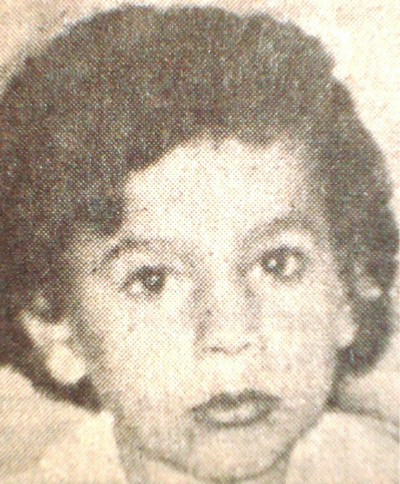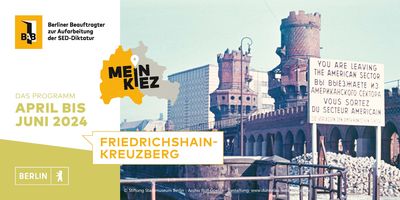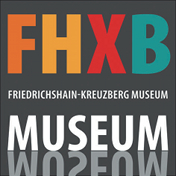
Ceremonial naming of the Çetin Mert Park
11th May | 3 pm | Green Space Skalitzer Str./Mariannenstr.
Çetin Mert (1970-1975) lived with his family in Kreuzberg. His mother Münevver was one of the first migrant workers to come to West Berlin from Turkey. On his 5th birthday, May 11, 1975, Çetin was playing on what was then Gröbenufer (now May-Ayim-Ufer) near Oberbaumbrücke when he fell into the Spree and drowned. The full width of the Spree belonged to East Berlin and entering the border area was life-threatening. He could not be rescued. Çetin Mert was one of the youngest victims of the division of Berlin (1961-1989). Before he died, four children had already drowned near the Oberbaum Bridge. After his death, there were protests by Berliners of Turkish origin. In October 1975, the Senate and the GDR government signed an agreement on rescue measures in the event of accidents in Berlin's border waters. To prevent further accidents, a fence was erected on the banks of the Gröbenufer.
The following spoke: Clara Herrmann (District Mayor Friedrichshain-Kreuzberg), Anna von Arnim-Rosenthal (Berlin Wall Foundation, Director of the East Side Gallery), Dr. Jens Schöne (Deputy Berlin Commissioner for the Reappraisal of the SED Dictatorship, BAB), Safter Çınar (Board Spokesman Turkish Federation in Berlin-Brandenburg). Musically framed by: Encan Acıkada.

Film evening “Mein Kiez. History(s) of the divided Berlin”
16th May | 6 pm | Roof top FHXB Museum
As a film student in 1991, Can Candan interviewed migrants of Turkish origin from Kreuzberg: What did the fall of the Wall mean for them and their everyday lives? What fears and hopes did they associate with it? How did they deal with the flare-up of racism?
In “Walls 2.0”, authors Jana König, Elisabeth Steffen and Inga Turczyn interview some of the participants in “Duvarlar” again: How do they view issues such as racism, nationalism and economic exploitation today? Are there new 'walls'? People from the eastern part of Berlin also have their say.
“Duvarlar - Mauern - Walls” (D, 2000), directed by Can Candan
Excerpts from the film “Walls 2.0 - migrant and anti-racist perspectives on the fall of the Wall” (D, 2011)
Film talk
Pia Eiringhaus, Curator Outreach at the Berlin Wall Foundation
Jana König, Head of Collection at the FHXB Museum
Inga Turczyn, freelance author and director for documentary film
Moderation: Nora Hogrefe, Head of the Coordination Office for Historical City Markings, Active Museum
Free admission
Reading in German spoken language
Wheelchair-accessible
A cooperation between the Berlin Reappraisal Commissioner and the FHXB Friedrichshain-Kreuzberg Museum.
Further information at
https://www.berlin.de/aufarbeitung/mein-kiez/artikel.1421814.php

Long Week of Neighbourhood History: city tours in Kreuzberg and Friedrichshain on 25 May, 29 May and 1 June
25. Mai | 29. Mai | 1. Juni
City tour 1:
Migrant self-organisation against racism and fascism
Saturday, 25 May, 1 pm
Meeting point: Garden of the FHXB Museum
On the city tour at Kottbusser Tor, the junction point of Kreuzberg's migration history since the 1960s, we will explore places of social dynamics of migrant self-organisation and resistance against racism and fascism together. A journey through time and space that brings us closer to the power of solidarity and political engagement in Kreuzberg.
Registration required
Contact: veranstaltungenfhxb-museum.REMOVE-THIS.de
City tour 2: 17 June 1953 in Friedrichshain
Wednesday, 29 May, 5 pm
Meeting point: Frankfurter Tor at the steps in front of the "Brewdog" pub
71 years ago, on 17 June, there was a nationwide popular uprising in the GDR. There are numerous biographical and geographical references in the Friedrichshain district around the former Stalinallee that can be discovered on this city tour.
Registration required
Contact: Tom-Aaron Aschke, tomaaron.aschkegmail.REMOVE-THIS.com
City tour 3: Power station, piano plague and coal mountain. A consumer and environmental history of Kreuzberg
Saturday, 1 June, 1:30 pm
Meeting point: Ohlauer Str./Paul-Lincke-Ufer
Environmental history is dedicated to the many interactions between humans and the environment. The fight against microbes will be just as much a part of the city tour as the change in household management and our role as consumers. We will also follow the many struggles of Berliners for public parks, cycle paths and an environment worth living in.
Registration required






